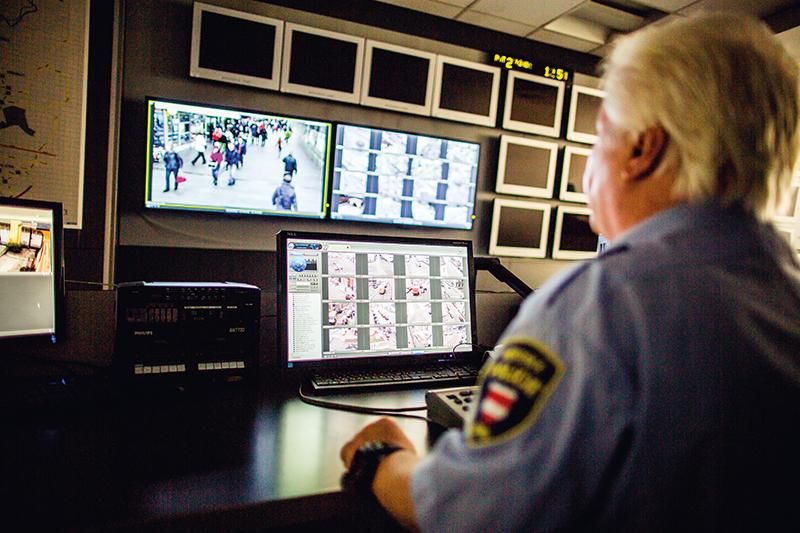Photos c/o Axis Communications.
The term smart building may seem like a buzzword or hi-tech fantasy, but just like smartphones and smart homes, smart buildings have become a modern-day reality. Integrating new technology into building design is an art that involves thoughtful planning, using data and the specialized expertise of consulting engineers, to take smart building from buzzword to mainstream.
What is a smart building, today?
We know that what makes a building “smart” is ever-changing and can differ between organizations depending on the needs and use of the facility. There are many areas that can fall into the realm of ‘smart,’ such as environmental, energy management, facility and property management, lifecycle management, security, etc. And a smart building may encompass many or all of these, while integrating them with automation.
Smart buildings by and large replace older analogue, stand-alone systems that need to be managed manually with digital, networked systems. Smart buildings may also include building management systems (BMSs), which are the platforms that tie systems together, enabling them to work in tandem and share information with each other to optimize the building’s needs and those of the visitors within.
AdvertisementDesigning for the future of technology
The migration of analogue systems to smarter, digital systems has helped change the landscape of technology across all industries, including construction. Building design has also evolved, moving from manual paper blueprints to robust digital architecture and engineering design tools. So how are emerging technologies being incorporated into intelligent building design at the planning and design phase? A couple of ideas come to mind: occupancy and visitor management.
The power of building-occupancy analytics
Properly identifying the use and occupancy of a building helps set the tone for the structure’s design. Building-occupancy analytics have been trending for years and with the onset of the pandemic, their importance has surged. The ability to accurately track the number of people coming in and out of a facility, as well as how many people are currently within it at any given time, provides a building operator or owner with data that can translate to an array of very useful applications.

More than just for occupancy limits, analytics can be a powerful tool for optimization and efficiency. For example, identifying high-traffic areas, along with peak- and low-occupancy times of day, can be used with HVAC and electrical systems to schedule and automate lighting and heating—ensuring areas are temperature-controlled and illuminated during peak occupancy times, while conserving energy by not heating, cooling or lighting spaces when not in use. Even building operations like cleaning schedules can be optimized using occupancy analytics. An area may only need cleaning services once a day when not in use or once an hour during high-occupancy times.
Using occupancy analytics to engage systems only where, when and how they’re needed can optimize both building and staff efficiency and reduce wear on critical systems.
Incorporating visitor management into smart design
Visitor/tenant management technology is increasingly being incorporated into building design with a multitude of applications. We’ve all encountered buildings equipped with push-button intercoms to gain entry. Today’s designs include low-touch entry systems and even no-touch entry, where a person can initiate a call without ever having to press a button. From the initial call, a full audio and video two-way conversation can be had before allowing entry into a building.
Not to be overlooked is remote management, where a person does not always need to be physically present in the building to monitor activity, engage with visitors or respond to security events. For instance, a QR code with a preset expiry can be generated and sent to a visitor’s mobile phone. Once the visitor holds the code up to an intercom, they are allowed facility access that will automatically expire after a single-use or at set time. Combined with network surveillance solutions, visitors and property are kept safe while the building is monitored remotely.
The right time to bring in smart security technology consultants
More and more organizations are relying on consulting services and they can be essential for those without in-house technical expertise. Consulting engineers have specialized skills and resources that go beyond just the fundamentals of building design (like mechanical, HVAC, plumbing and electrical). They also bring a wealth of skills and experience to help get the most out of smart building design, from network video and audio for security to supporting infrastructure, cybersecurity, remote management and much more.
When incorporating smart technology into a new project, the earlier in the planning phase the conversation starts, the better. This allows time for consultants to ask the right questions, assess needs, vet the right technologies and determine what infrastructure is available or required to support them. The dynamics of a project change depending on whether it’s a new building being constructed or a retrofit of an existing facility, where legacy systems may be replaced altogether or integrated with new technology. As a result, proper planning often requires working with multiple vendor channels to provide a total solution, so it’s always best practice to start as early into the project plan as possible.
Gavin Daly is the architect and engineering manager at Axis Communications. He provides technical expertise and personalized advice for both internal and external customers. Gavin can be reached for consultation at gavin.daly@axis.com.








